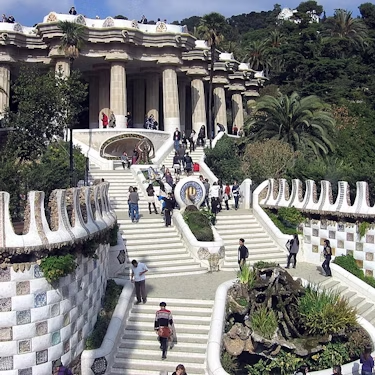More about: 10 Best Gaudi Buildings in Barcelona
If there is something you can not miss when planning what to see and do in Barcelona are the works of Gaudí. The brilliant architect left his mark on much of the city and there is no doubt that visiting his best creations is a must on a visit to the Catalan capital.
La Pedrera and Park Güell are just two of the many works carried out by the architect from Reus. The Catalan capital hosts a good number of works and our article reveals the best ten. The first is located a few meters from Las Ramblas, the most famous street in Barcelona.
1. Street lamps in Plaça Reial
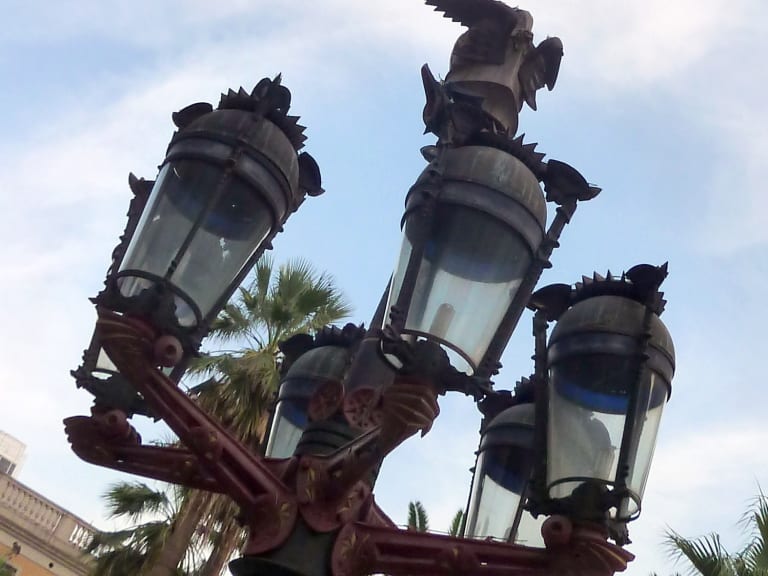
When Gaudí was working on the Parc de la Ciutadella - not as the main architect but as an assistant - he was noticed by the city council. This talented young man deserved an opportunity that materialized with the commission for the public lighting of two urban esplanades: Plaça Reial and Pla del Palau. Today, only the first street lamps survive, which are intermingled between the fountain and the palm trees.
The lampposts are characterized by elements such as the iron medallion with floral motifs and the coat of arms of Barcelona. The square is located in the Gothic quarter and hosts two mythical concert halls of the city: Sidecar and Jamboree.
2. Casa Milà (La Pedrera)

It was the last residential building built by Gaudí. The client was Pere Milà, a young and successful businessman devoted to novelties. He was the first to drive a car in Barcelona and his figure deserves a separate chapter. When the works were finished, he and his wife Roser Segimon moved into the main floor and rented the remaining ones.
The rough hewn limestone facade was built with rocks from the Garraf Massif and Vilafranca del Penedès, both south of Barcelona. Gaudí molded them as if they were a cliff and added the witch-scaring chimneys, balconies with iron decorations and other artistic details. From the outside you can see the main entrance protected by a large iron gate.
The interior is just as impressive. The fourth floor Pedrera Floor houses a permanent exhibition that recreates a home of a Barcelona family of the early twentieth century. I recommend you book tickets in advance, it is a busy attraction and it is preferable to avoid queues or possible disappointment.
3. Park Güell
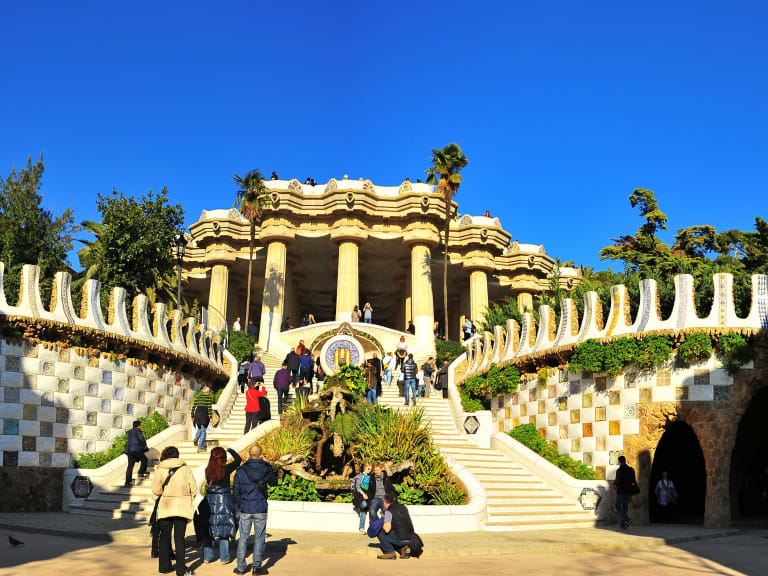
The highest part of the Grácia neighborhood holds one of Barcelona's treasures: Park Güell. Few cities can boast of having such a suggestive green area. Paths, trencadís sculptures, colonnades and other typical details of the architect from Reus are wrapped in vegetation, a detail that is appreciated in summer. The origin of this urban space is due to the wealthy businessman Eusebi Güell, a name that you will read again throughout the post.
From its viewpoint you can appreciate one of the best views of the city. It is a typical image of the city: the picturesque Casa del Guarda in the foreground with the skyline of the capital and the Mediterranean in the background.
Being located on a hill, the streets are quite steep. Luckily, escalators connect Baixada de la Glòria (near Vallcarca metro station, line 3) and Avinguda del Santuari de Sant Josep de la Muntanya, a street just a few meters from the entrance.
4. Sagrada Familia

It is the icon of Barcelona and the most visited monument in the city. Gaudí started working on the construction in 1883 and never saw the end of the work. In reality the basilica is still under construction and when it is finished it will be the tallest in the world.
You may not know that Gaudí took over from the architect Francisco de Paula del Villar who had received the commission a few years earlier. His project designed a neo-Gothic temple of a more classical style.
From the outside, what stands out most are the towers decorated with scenes of Jesus' birth, passion, death and resurrection. Two of these watchtowers - the Passion Tower and the Christmas Tower - have elevators that reach the panoramic point. From here you can enjoy a wonderful view over the city, the coast and the Sierra de Collserrola.
If you want to discover what is hidden inside, I recommend you to read the dedicated article.
5. Batlló House

No one can remain indifferent in front of its facade. When Gaudí was commissioned by D. Josep Batlló y Casanovas he was able to give free rein to his imagination. It is a surprising residence that according to the most accepted theory pays homage to the legend of Sant Jordi (St. George). If you look up you will see a roof decorated with blue, green and reddish tiles; when the sun shines on it, it looks even more like a dragon.
Booking a ticket will give you the opportunity to tour the interior. The first environment you will see is the lobby, a cozy space that evokes the marine world. Another magical spot is the Patio de luces with its tiles in different shades of blue. In Casa Batlló everything is cared for down to the smallest detail, from the Noble Floor to the attic. To decorate the rooms Gaudí involved the best craftsmen of the time and the result will leave you breathless.
It is located at number 43 Passeig de Gràcia at a short distance from other modernist wonders. Next to it stands the extravagant Casa Amatller by Josep Puig i Cadafalch. The avenue is also home to the famous Pedrera.
6. Güell Pavilions

These are the gardens of the summer palace of the businessman Eusebi Güell. They are located next to the Royal Palace of Pedralbes and about fifteen minutes walk from the Spotify Camp Nou. At the main entrance stands out the spectacular wrought iron grille representing the myth of Ladon, a dragon who was defeated by Hercules.
7. Bellesguard Tower

This work of Gaudí is the perfect excuse to visit Sarrià - Sant Gervasi, a residential district that is off the traditional tourist routes. However, it is worth a stroll through its streets; in addition to the Torre Bellesguard it is home to elegant squares, the modernist residences of Avenida Tibidabo and Foix, one of the best pastry shops in the city.
Back to business, the Torre Bellesguard is a neo-medieval style building that stands on the foundations of an ancient castle.
Gaudí restored the original construction, recovered the external walls and added details typical of his creativity, such as the four-pointed pinnacle that embellishes the watchtower, the slate stone cladding or the trencadís, mosaics made with irregular fragments of ceramic and joined with mortar.
Some weekends, at the foot of this magnificent building, Bcn en las alturas, a market dedicated to fashion, decoration, art and gastronomy, is organized. Tickets cost around 5 € and the opening hours are from 11:00 to 22:30 (Friday, Saturday and Sunday).
8. Palau Güell

A few meters from Las Ramblas is a hidden gem of Modernism: Palau Güell. It was completed in 1890 and represents the zenith of Gaudí's youth.
The architect took the opportunity to try new solutions and adopt those features that would have made him famous. For example, 20 chimneys protrude from the building and all are decorated with the typical trencadís.
Palau Güell is the only building that Gaudí was able to finish, quite an achievement considering the genesis of the Sagrada Familia. The genius of Reus adapted the residence to the environment; being located in a small street in the Raval neighborhood, the exterior is not very ostentatious while the interior stands out for its elegance and magnificence.
It is located at Carrer Nou de la Rambla 3/5 and is open from 10:00 to 20:00 (April to October) and from 10:00 to 17:30 (November to March).
9. Vicens House
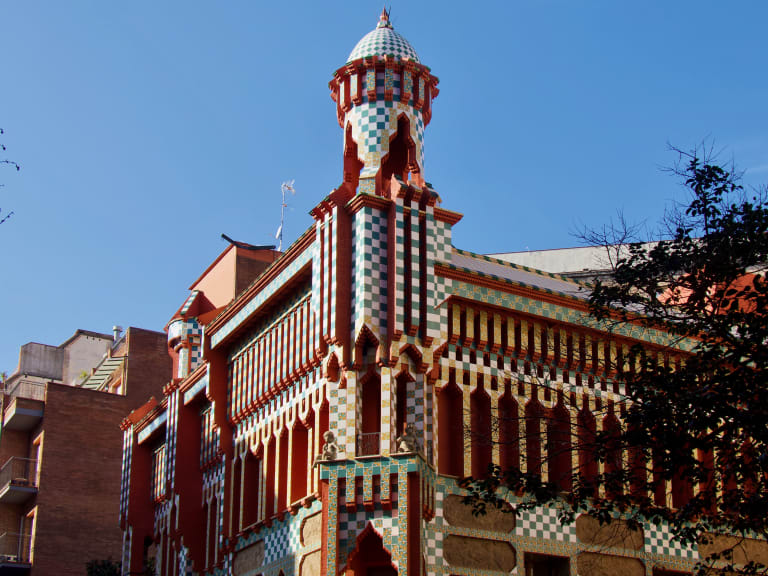
A modernist small house in the heart of Gràcia. It was the first work of a certain size of the architect from Reus who built it at the end of the 19th century commissioned by Manuel Vicens i Montaner.
Gaudí was inspired by nature and designed a residence decorated with flowers and botanical motifs. Since 2017 Casa Vicens has become a house museum. If you travel in spring it is even more recommendable as it is surrounded by a beautiful garden.
10. School of Santa Teresa Ganduxer

From afar, this school in the Sarriá - Sant Gervasi neighborhood looks like a building halfway between a Moroccan kasbah and a Gothic palace. Whether it is the palm trees in the garden or perhaps the reddish bricks that make up its austere facade, what is certain is that it has an exotic yet fascinating appearance.
Gaudí designed this structure to house a school and the house of the order of Santa Teresa. Unfortunately it cannot be visited as it is still a school.
Are there more of Gaudí's works in Barcelona?
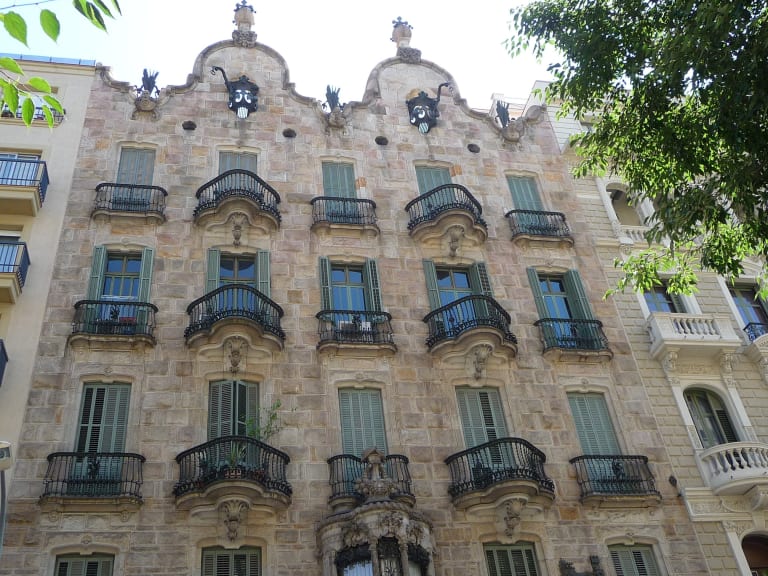
Of course! The above list is limited to listing the best ones. One of the most traditional and often forgotten works is Casa Calvet. It was commissioned by the eponymous textile entrepreneur who wanted a new headquarters for his business as well as family residence. Its façade may look classical, but it has typical Art Nouveau elements.
Today, the first floor houses China Crown, a restaurant specializing in imperial Chinese food.
Other landmarks are the Hercules Fountain (not heard of until 1984. It is located in the gardens of the Pedralbes Palace), the mosaic of the Church of Sant Pacià (in the district of San Andreu) and the Portal Miralles, a monumental entrance in the Sarriá district.
Are there Gaudí's works around Barcelona?

Of course there are! He was a very famous architect and his works are not limited to Barcelona. If you plan to stay in Barcelona for more than three days you can take the opportunity to explore its surroundings. The following list gathers the destinations that bear the signature of the Catalan genius:
- Colonia Güell, a complex that brings together a textile factory, workers' housing, a school, the doctor's house and a church known as Gaudí Crypt. It is located in Santa Coloma de Cervelló, a village a short distance from Barcelona. Eusebi Güell decided to move the company here to avoid the spread of union ideas that were causing many strikes in Barcelona. You can get here by metro line 8. You should get off at the stop Molí Nou - Ciutat Cooperativa and walk for a few minutes.
- Artigas Gardens. This destination will take you to La Pobla de Lillet, a municipality surrounded by mountains. In the green area, the Llobregat river mixes with the bridges and paths designed by the architect from Reus. To get there you will have to take an Alsa bus or rent a car.
- Nau Gaudí, the architect's first project. At the end of the 19th century, the businessman Salvador Pagés commissioned him to build the factory premises of the Sociedad Cooperativa Obrera Mataronense. Only two buildings survived the passage of time: the cotton bleaching shed and the latrine pavilion.
If you are traveling in summer, you might want to visit a piece of architecture on the Costa Dorada. Between Sitges and Castelldefels stand the Bodegas Güell, one of the many works commissioned by the eponymous entrepreneur.
From the outside, this stone building looks like a castle from the Middle Ages. Its particularity lies in the stone roof; it is not a simple roof but a wall that surrounds the cellars. It now houses a restaurant.



